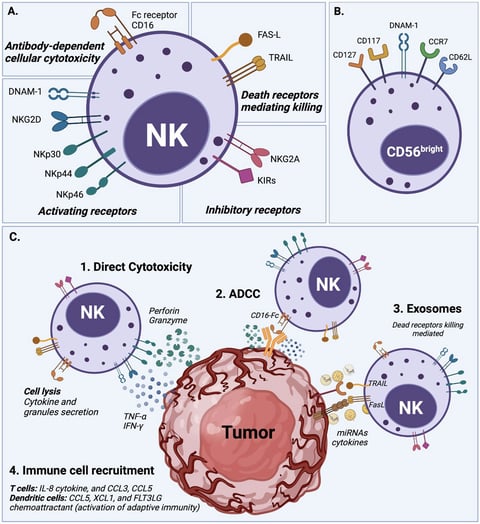
Natural Killer (NK) Cells

What are NK Cells?
NK Cells are special cells with the ability to activate themselves upon recognition of “Stress” or “Danger” signals independently of Major Histocompatibility Complex (MHC) engagement, thus making tumor cells a perfect target for NK cell-mediated cancer immunotherapy even as an allogenic solution. Unlike other immune cells, NK cells can act without the need for prior exposure to a pathogen or tumor, making them "natural" defenders and the prime alternative for front line therapeutics.
Surveillance and Target Recognition:
NK cells patrol the body continuously, looking for anomalies in cells. They can identify cells that are under stress, infected (particularly by viruses), or developing into cancerous cells. NK cells use a balance of signals from activating and inhibitory receptors on their surface to determine whether to attack a target cell, in contrast to T cells, which need antigen presentation to activate.
Killing Mechanism:
When NK cells identify a dangerous or aberrant cell, they have two primary ways to eliminate it:
NK cells release cytotoxic granules, which include granzymes and perforin. Granzymes can enter the target cell through the holes perforin makes in its membrane, causing apoptosis.
Activation of death receptors: NK cells can also interact with target cell surface death receptors (like Fas and TRAIL receptors) to start programmed cell death.
Cytokine Production:
In addition to killing infected or cancerous cells, NK cells produce cytokines like interferon-gamma (IFN-γ), which help shape the immune response by activating other immune cells, including macrophages and dendritic cells. This helps further coordinate the body's defense mechanisms.
Immune Memory-Like Response:
NK cells were traditionally thought to only belong to the innate immune system, lacking memory. However, recent research suggests that NK cells can develop "memory-like" properties, meaning they can remember and respond more effectively to previously encountered threats, somewhat similar to how T cells work in adaptive immunity.
Overall, NK cells are essential in controlling viral infections and preventing the spread of cancer. They can eliminate threats in a rapid, non-specific way while also contributing to longer-term immune responses.
NK Cells for Cancer Treatment
Since their discovery in the 1970s, Natural Killer (NK) cells have been used as anticancer treatments due to their ability to recognize and kill malignant cells without prior priming and independent of MHC-I molecules. Unlike T cells, NK cells do not require antigen priming and instead recognize markers of "missing self" or "induced self-recognition" in abnormal cells. NK cell therapy has shown promising results in treating hematologic cancers such as leukemia, lymphoma, and multiple myeloma, as well as solid tumors including melanoma, breast cancer, liver cancer, ovarian cancer, and kidney cancer.
Autologous NK cell therapy, which uses a patient’s own NK cells, is a promising option when donor cells are limited or unavailable. Autologous NK cells are easier to obtain and avoid complications like poor persistence in an immune-incompatible environment, making them a valuable alternative in cancer treatment.
NK cell activation and natural cytotoxicity.
(A) Overview of NK cell receptors. All described cytotoxicity mechanisms are in response to an orchestrated balance of activating receptors (e.g., DNAM-1, NKG2D, NKp30, NKp44, NKp46) and inhibitory receptors (e.g., NKG2A, KIRs family) that determine the NK cell activation state.
(B) Phenotype of circulating CD56bright NK cells which typically express DNAM-1, CD62L (L-selectin), and CCR7, but also in some cases CD117 (c-kit), and CD127 (IL-7Rα).
(C) NK cells have a natural ability to recognize abnormal cells and exert cell cytotoxicity through different mechanisms.
(1) NK cells exert direct cytotoxicity against compromised cells mainly by the secretion of IFN-γ and TNF-α cytokines, and the release of perforin and granzyme cytolytic granules.
(2) Antibody-dependent cellular cytotoxicity (ADCC) is another mechanism of NK cell cytotoxicity, which is mediated by the CD16 (FcRIII) receptor after recognizing and bound target cells.
(3) NK cells display dead receptors, FAS-L and TRAIL, and exert their killing capability against compromised cells through the release of exosome that contains small non-coding RNAs (miRNAs) and cytokines. (4) The immune cell recruitment of T cells and dendritic cells also plays an essential role in NK cell cytotoxicity to enhance their action through soluble cytokine IL-2 and chemokine (CCL3, CCL5, XCL1, and FLT3LG) secretion.
How NK Cells Work:


Suite 2-3, Wisma Life Care, 5, Jalan Kerinchi, Kuala Lumpur, Malaysia, 59200
+ (60)163225035 (WhatsApp)


